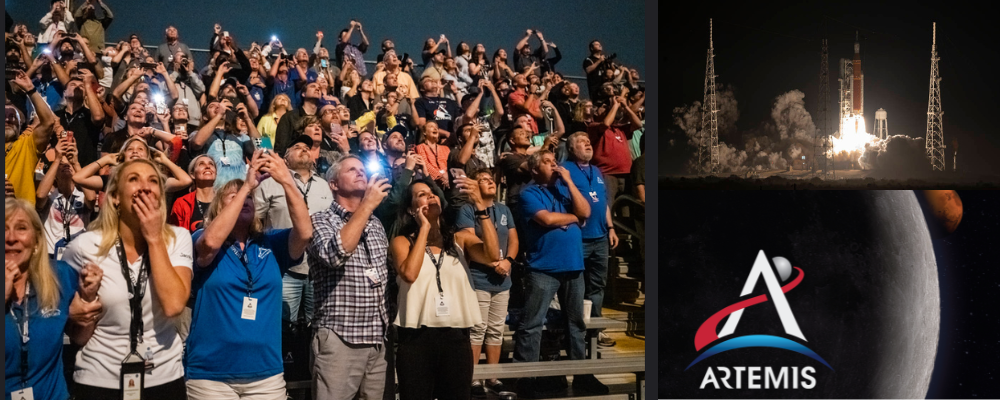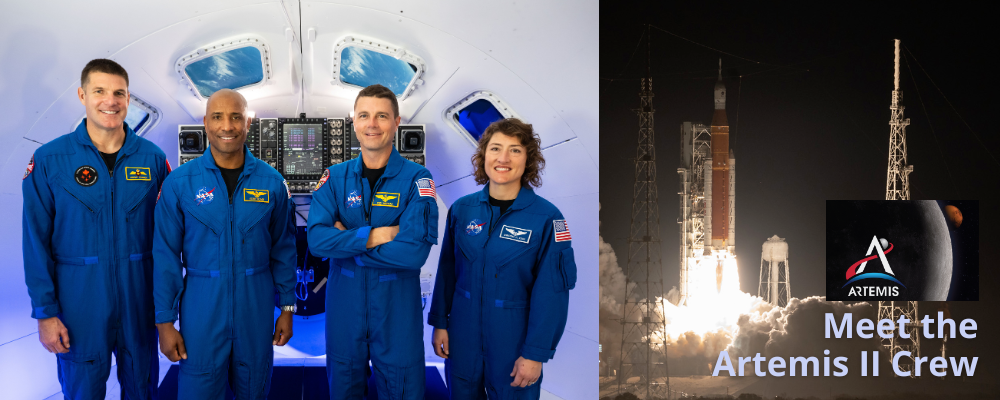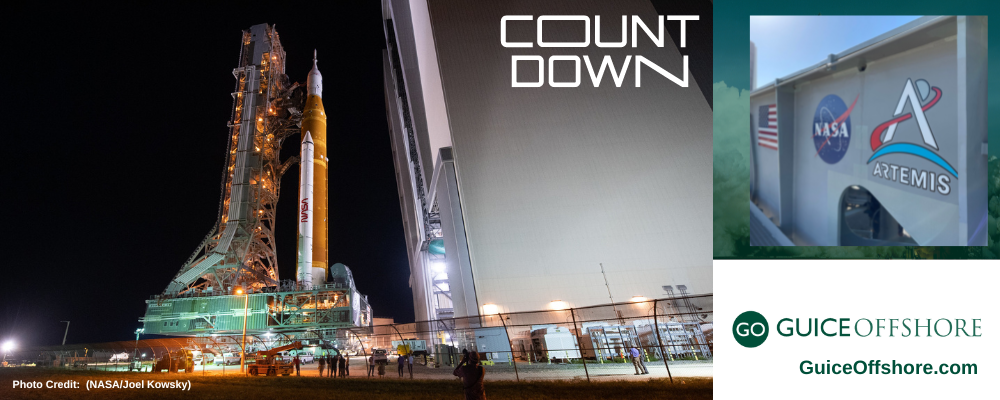Guice Offshore salutes America’s best and brightest nationwide and their international partners for their successful launch of NASA’s Space Launch System (SLS), the most powerful rocket in the world. After liftoff during the very early morning hours of Wednesday, November 16, 2022, NASA’s uncrewed Artemis 1 spacecraft is on its way to the Moon for the first part of its mission.
“Seven, six, five, core stage engine start, three, two one, booster ignition and liftoff of Artemis 1!” exclaimed NASA commentator Derrol Nail from the launch control center. “We rise together back to the moon and beyond!”
In what was essentially a test flight, the SLS lifted off for its dramatic debut at 1:47 a.m. EST from Launch Pad 39B at NASA’s Kennedy Space Center in Florida.
The launch marks the first leg of a mission in which Orion will travel approximately 40,000 miles beyond the Moon and return to Earth over the course of 25.5 days. Known as Artemis I, the mission is a critical part of NASA’s Moon to Mars exploration approach, in which the agency explores for the benefit of humanity. It’s also an important test for the agency before flying astronauts on the Artemis II mission.
“What an incredible sight to see NASA’s Space Launch System rocket and Orion spacecraft launch together for the first time. This uncrewed flight test will push Orion to the limits in the rigors of deep space, helping us prepare for human exploration on the Moon and, ultimately, Mars,” said NASA Administrator Bill Nelson.
After reaching its initial orbit, Orion deployed its solar arrays and engineers began performing checkouts of the spacecraft’s systems. About 1.5 hours into flight, the rocket’s upper stage engine successfully fired for approximately 18 minutes to give Orion the big push needed to send it out of Earth orbit and toward the Moon.
Orion has separated from its upper stage and continued on its outbound coast to the Moon powered by its service module, which is the propulsive powerhouse provided by ESA (European Space Agency) through an international collaboration.
“It’s taken a lot to get here, but Orion is now on its way to the Moon,” said Jim Free, NASA deputy associate administrator for the Exploration Systems Development Mission Directorate. “This successful launch means NASA and our partners are on a path to explore farther in space than ever before for the benefit of humanity.”
Over the next several hours, a series of 10 small science investigations and technology demonstrations called CubeSats deployed from a ring that connected the upper stage to the spacecraft. Each CubeSat has its own mission that has the potential to fill gaps in our knowledge of the solar system or demonstrate technologies that may benefit the design of future missions to explore the Moon and beyond.
Orion’s service module will also perform the first of a series of burns to keep Orion on course toward the Moon approximately eight hours after launch. In the coming days, mission controllers at NASA’s Johnson Space Center in Houston will conduct additional checkouts and course corrections as needed. Orion is expected to fly by the Moon on Nov. 21, performing a close approach of the lunar surface on its way to a distant retrograde orbit, a highly stable orbit thousands of miles beyond the Moon.
“The Space Launch System rocket delivered the power and performance to send Orion on its way to the Moon,” said Mike Sarafin, Artemis I mission manager. “With the accomplishment of the first major milestone of the mission, Orion will now embark on the next phase to test its systems and prepare for future missions with astronauts.”
The SLS rocket and Orion spacecraft arrived at Kennedy’s Launch Pad 39B on Nov. 4 where they rode out Hurricane Nicole. Following the storm, teams conducted thorough assessments of the rocket, spacecraft, and associated ground systems and confirmed there were no significant impacts from the severe weather.
Engineers previously rolled the rocket back to the Vehicle Assembly Building (VAB) Sept. 26 ahead of Hurricane Ian and after waving off two previous launch attempts Aug. 29 due to a faulty temperature sensor, and Sept. 4 due to a liquid hydrogen leak at an interface between the rocket and mobile launcher. Prior to rolling back to the VAB, teams successfully repaired the leak and demonstrated updated tanking procedures. While in the VAB, teams performed standard maintenance to repair minor damage to the foam and cork on the thermal protection system and recharge or replace batteries throughout the system.
Artemis I is supported by thousands of people around the world, from contractors who built Orion and SLS, and the ground infrastructure needed to launch them, to international and university partners, to small businesses supplying subsystems and components. To see a map of the United States affiliates, click here.
Through future Artemis missions, NASA will land the first woman and the first person of color on the surface of the Moon, paving the way for a long-term lunar presence and serving as a steppingstone for astronauts on the way to Mars.
View more photos of Artemis I at: https://flic.kr/s/aHBqjzG1pG
What Happens When Artemis 1 Returns to Earth?
Guice Offshore works with the aerospace and space industries principally in the complex logistical and high security process of ocean recovery. With powerful cranes and winches, Guice Offshore support vessels are able to retrieve capsules and other manned or unmanned space or aeronautics machinery from the ocean, while providing plenty of deck space to carry them, along with their support crew and equipment.
Aerospace represents an important and growing segment of the global economy and the maritime sector. The industry has been principally focused on the activities centered around space craft and space flight originally for governments, but now ever-expanding to address commercial needs and even eco-tourism. This broad and complex business is often associated with research and development projects and recovery operations, all of which Guice Offshore assists in offshore operations.
In its extensive Artemis reference guide HERE, NASA explains the recovery process in detail specific to how it will take place when the Orion capsule is scheduled to splash down on December 11, 2022.
In addition to the hardware elements that are part of the ground systems supporting launch, the landing and recovery team led by NASA’s Exploration Ground Systems (EGS) from Kennedy Space Center will be responsible for safely recovering the Orion capsule, as well as crew on future missions , and returning them to land after splashdown.
The Artemis interagency landing and recovery team consists of personnel and assets from the U.S. Department of Defense–including Navy amphibious specialists and Air Force weather specialists–together with engineers and technicians from Kennedy and Johnson Space Centers, and Lockheed Martin.
Before splashdown of the spacecraft, the recovery team will head out to sea in a Navy amphibious ship that has a well deck at the waterline to allow boats to dock inside the back of the ship. At the command of the NASA recovery director, Navy divers and other team members in several inflatable boats will approach Orion. When Orion is ready to be pulled into the well deck, the divers will attach a cable (known as the winch line), and up to four additional tending lines to attach points on the spacecraft to pull the spacecraft into the ship. The winch will pull Orion into a specially designed cradle inside the ship’s well deck, and the other lines will control the lateral motion of the spacecraft.
Once Orion is positioned above the cradle assembly, the team will drain the well deck and secure Orion on the cradle. During a crewed mission, astronauts can be recovered in either open water or the well deck of the ship, depending on sea conditions and other factors on the day of landing. For an open-water crew egress, the Navy divers will install a stabilization collar around the spacecraft as well as an inflatable platform, known as the front porch, to assist with stabilizing Orion and helping recover the astronauts.
During crew recovery in the well deck, technicians will pre-position a crew egress stand to access and recover the crew after the spacecraft is fully recovered into the well deck. Open-water personnel will work to recover Orion’s forward bay cover and three main parachutes to the port side of the Navy ship, where a crane will lift them onto the ship’s main deck.
If teams recover the jettisoned cover and parachutes, engineers can inspect the hardware and gather additional performance data. Teams will transport the spacecraft and other hardware on the ship from the landing site to a pier at U.S. Naval Base San Diego.
After technicians secure Orion and the other associated hardware in the recovery transportation fixture (a platform nicknamed the Armadillo), they will transport the hardware by truck to Kennedy Space Center.
Underway Splashdown Recovery Testing
In the Artemis Reference Guide, NASA explains that teams have practiced procedures and operations in Johnson’s Neutral Buoyancy Laboratory pool and in open water off the coast of California during a series of underway recovery tests by using a test version of the Orion spacecraft and other equipment that will be used during recovery operations. The term “underway” refers to recovery tests done when a ship is at sea.
These tests helped to evaluate and improve recovery procedures and hardware ahead of Orion’s flight on Artemis I and will be repeated prior to the first crewed mission, Artemis II. Testing also included recovering the spacecraft from Orion’s first flight test, EFT-1, when Orion splashed down in the Pacific Ocean about 600 miles off the coast of San Diego, California at the end of the test.
A 50-State Global Effort
Since its inception, every state in America has made a contribution to the success of NASA’s Artemis program, with companies hard at work on innovations that will help establish a sustainable human presence at the Moon. Men and women across America and in Europe are building the systems to support missions to the Moon, Mars and beyond. These missions are critical to the space economy, fueling new industries and technologies, supporting job growth, and furthering the demand for a highly skilled workforce.
NASA is continuing America’s journey of discovery by developing space technologies and building the next-generation rocket, spacecraft, landers, and ground systems operations to facilitate missions into deep space—beyond the Moon and eventually to Mars.
- Orion is the first spacecraft in history capable of carrying humans on long-duration missions in deep space. NASA’s prime contractor for Orion is Lockheed Martin Space Systems Company.
- The Space Launch System (SLS) is the rocket capable of launching humans, habitats, and support systems directly into deep space. It is designed to be both powerful and flexible for a crew, cargo, or science missions. NASA’s prime contractors for SLS include Aerojet Rocketdyne, Boeing, and Northrop Grumman.
- Exploration Ground Systems (EGS) is adapting existing infrastructure and facilities to modernize NASA’s lunar spaceport at the agency’s Kennedy Space Center in Florida, capable of launching spacecraft built and designed by both NASA and private industry. NASA’s prime contractor for EGS is Jacobs.
NASA Prime Contractors Aerojet Rocketdyne, Boeing, Jacobs, Lockheed Martin, and Northrop Grumman currently have over 3,800 suppliers contributing to Orion, the SLS rocket, and the lunar spaceport at Kennedy. With NASA investments, additional U.S. companies, including small businesses, are advancing technologies and systems needed for a sustained presence on the Moon by 2028.
- The Gateway will be an outpost orbiting the Moon and providing vital support for a sustainable and long-term human return to the lunar surface. The Gateway will have components from U.S. companies, as well as international partners. It will provide access to more of the lunar surface than ever before with living quarters for astronauts, a lab for science and research, ports for visiting spacecraft, and more.
- The Human Landing System will carry astronauts to the lunar surface and launch them back to lunar orbit when their expedition is complete. Streamlining its partnering approach, NASA is working with three American companies – Blue Origin, Dynetics, and SpaceX – to begin development of their industry-led innovative designs for human landing systems.
- Through NASA’s Commercial Lunar Payload Delivery Services (CLPS), American companies of varying sizes will bid on delivering science and technology payloads to the surface of the Moon.
- Tipping Point awards support industry-developed space technologies that can foster the development of commercial space capabilities and benefit future NASA missions. A technology is considered at a tipping point if an investment in a demonstration will significantly mature the technology and bring the technology to market for both government and commercial applications.
- NASA’s Announcement of Collaboration Opportunity (ACO) helps reduce the development cost of commercial space technologies and accelerate their infusion into future missions.
- The Game Changing Development (GCD) program identifies and rapidly matures high-impact capabilities and space technologies.
- NASA’s Small Business Innovation Research (SBIR) program provides an opportunity for small companies and research institutions to participate in government-sponsored research and development efforts in key technology areas.
While the Artemis Partners map highlights the United States, this endeavor reaches internationally, extending to collaboration with NASA on components for the Gateway and Orion. With the support of many European suppliers, the ESA (European Space Agency) is continuing to outfit the Orion spacecraft’s service module for Artemis I and subsequent flights. International contributions to the Gateway have not yet been determined.
- Click to read the latest Artemis News and Features.


